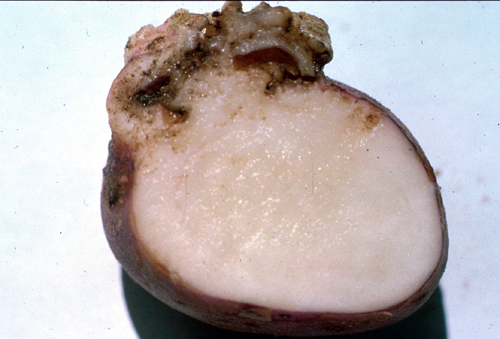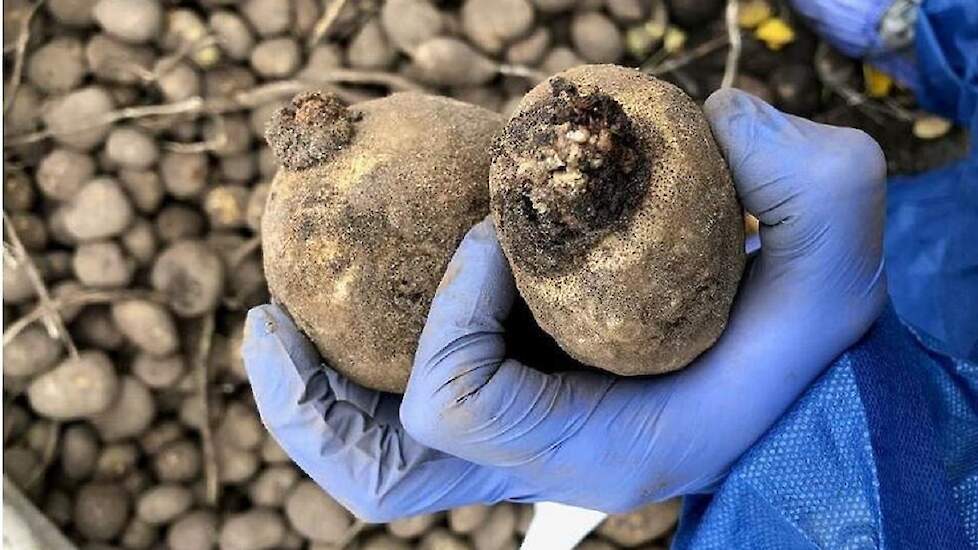The discovery of wart disease on two plots in the Peat Colonial area is a cause for concern for the potato sector. The infection was found in Festien, a variety with a high resistance rate. Thanks to favorable conditions during the growing season, the fungal disease was able to develop in this variety, despite the high resistance rate. Is an 8 or a 9 still sufficient in the fight against wart disease?
Despite the relatively low number of finds, wart disease is a serious problem in potato cultivation. It is a soil-borne disease that can survive in the soil for many years. The most important host plant is the potato, the most important way of spreading is via seed potatoes and soil. In order to prevent further spread after a find, potatoes and propagating material may no longer be grown on infected plots for a period of 20 years.
Wart disease is caused by the fungus Synchytrium endobioticum. This fungus has quarantine status in the EU. There are different races of the fungus, of which race 1, 2, 6 and 18 occur in the Netherlands. Fysio 1 occurs in the Southeast Netherlands and the other physios in the Northeast Netherlands. The previous discovery of wart disease was in 2015 on a plot in the vicinity of Borger. After investigation it turned out that there was physio 18.
There are differences in regulations per race, for example in the case of the cultivation ban of twenty years. Depending on the type of physio, relaxation is possible after five years. If it concerns Physio 18, a so-called core area with a radius of 1 kilometer around this plot is established around the infected plot. Within such a core area, the variety choice for starch potato cultivation is smaller than in the surrounding area.
Variety choice
Variety selection is an important factor in reducing the risk of infection with wart disease. Many varieties are known for their resistance to wart disease. The higher the number, the more resistant the variety is to the fungus. Varieties with the mark 10 are resistant, the mark 7 or 8 is considered ‘slightly susceptible’ to physio 18. With a mark of 7 or 8 the expression of warts is not excluded, Arjan de Rooij, Agro director at Avebe knows. Festien has a resistance score of 8 for races 1 and 18, and a 9 for races 2 and 6. Can a variety with such resistance figures still be grown safely? It is still too early to say anything about that, says De Rooij. “The investigation by NVWA is still ongoing, it is also not yet known which type of wart disease this concerns.”
In case of suspicion of wart disease in the field or in the immediate vicinity, the NVWA advises to cultivate a variety with the highest possible resistance. “Preferably a 10”, says sector manager arable farming Bert Waterink of the NVWA. “If it does not occur in the immediate vicinity or on the plot, a lower figure will suffice.” What matters is whether the fungus is in the soil or not.

The most important starch potato varieties have a resistance rating of 10 or 9. “You will never discover a wart on them,” says Waterink. “But you are killing the disease with it, because it cannot reproduce on these breeds. So if you have grown varieties with a 10 or a 9 for several years, the fungus will slowly die out through natural death. ”
Business hygiene
In addition, company hygiene plays an important role. Wart disease can be prevented by using clean machines and tools, by not depositing contaminated soil on your own plots and by preventing wind erosion. But that does not cover the risk. The grower with whom the infections were found is known as a neat grower who works according to the rules of company hygiene. It is not yet clear what exactly is the cause of the infections here.
Under favorable conditions for the fungus, the disease can still reveal itself despite all preventive measures. Fungi generally thrive in moisture and temperature. Under average conditions (in terms of environmental factors and a low density of resting spores in the soil) hardly visible wart formation will occur in easily susceptible varieties. However, if small warts are formed in a period with a lot of moisture (rain), and if the soil remains moist for a long time after that initial wart formation, a small wart can grow into a large wart. In this way many and large warts can develop.
Sieve soil
To make sure that the fungus is not also in other places in the ground, the NVWA has investigated the presence of wart disease in a radius of 5 kilometers around both infected plots. Plots and sieve soil were inspected for the possible presence of wart-like structures. This has not led to more finds.
The contaminated party Festien is still on the land. The potatoes are shipped under the supervision of the NVWA. However, the loading and transport equipment must be cleaned and disinfected. According to the NVWA, the batch of potatoes can be processed safely by Avebe.
Do the new finds mean that growers need to be extra vigilant? “Resistance to wart disease in the choice of variety has always been an important point of attention for growers of starch potatoes, disease resistance is even more important than yield,” says De Rooij. “As Avebe, we will continue to emphasize that growers are advised to choose varieties with the highest possible resistance rate.”
